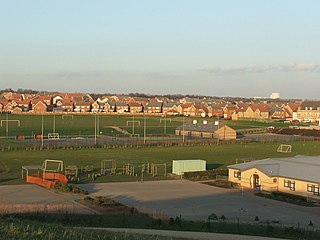
Hampton is a developing township to the south of Peterborough, in the Peterborough district, in the ceremonial county of Cambridgeshire, England.

The Cotswold Water Park is the United Kingdom's largest marl lake system, straddling the Wiltshire–Gloucestershire border, north-west of Cricklade and south of Cirencester. There are 180 lakes, spread over 42 square miles (110 km2).
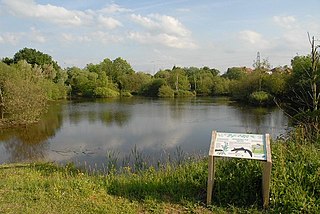
Rixton Clay Pits is a former clay extraction site in Rixton, near Hollins Green, Warrington, England. Formerly farmland, boulder clay extraction started in the 1920s for brick making in the adjacent brickworks and ceased in 1965 – since then it has been allowed to return to nature. It is now an area of ponds, scrub, woodland and damp grassland. It is owned and managed by Warrington Borough Council as a local amenity.
Ashford Green Corridor is a green space that runs through the town of Ashford in Kent, England. The Green Corridor is made up of parks, recreation grounds and other green spaces alongside the rivers that flow through Ashford. It is a Local Nature Reserve.

Newt fencing is a barrier designed to control the movement of great crested newts, other amphibians or reptiles. It can also be called drift fencing or temporary amphibian fencing (TAF). It consists of a low fence of plastic sheeting, buried a short way into the ground and supported by lightweight posts usually made of wood or plastic. It is used to keep animals out of working areas, to keep them inside safe areas of their habitat, to intercept migration routes, or to control their movement to help their capture for translocation. It may be used in conjunction with pitfall traps placed at the foot of the fence. It is most commonly used in connection with building projects, to minimise harm to protected species.

Stanground Newt Ponds is a 0.8-hectare (2.0-acre) nature reserve in Peterborough in Cambridgeshire. It is managed by the Wildlife Trust for Bedfordshire, Cambridgeshire and Northamptonshire.
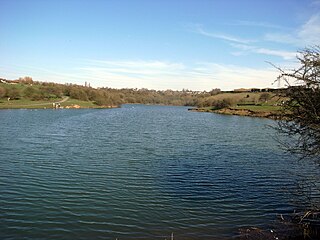
Fens Pools is a 37.6 hectares biological site of Special Scientific Interest in the West Midlands. The site was notified in 1989. under the Wildlife and Countryside Act 1981 and is currently managed by the Country Trust.
Witton-le-Wear (SSSI) is a Site of Special Scientific Interest located in the valley of the River Wear, immediately east of the village of Witton-le-Wear in County Durham, England.

Woorgreens Lake and Marsh is a 9-hectare (22-acre) nature reserve in Gloucestershire.

Cranham Brickfields is an 8.5 hectare Local Nature Reserve and a Site of Borough Importance for Nature Conservation, Grade I, in Cranham in the London Borough of Havering. It has an area of woodland with a pond, wildflower meadows, and a grassed area with a children's playground. The site was formerly used for excavating clay to make bricks, and during the Second World War vegetables were cultivated as part of the Dig for Victory campaign. Wildlife includes bullfinches, great crested newts, stag beetles and green hairstreak butterflies. There is also dyer's greenweed, which is rare in London.

Hertford Heath nature reserve is a 28 hectare biological Site of Special Scientific Interest in Hertford Heath in Hertfordshire. It is managed by the Herts and Middlesex Wildlife Trust and the local planning authority is East Hertfordshire District Council.

Havannah Nature Reserve lies to the west of the village of Hazlerigg, approximately five miles north of the centre of Newcastle upon Tyne in the north of England. It was declared a nature reserve in 1998 and is designated a Site of Local Conservation Interest. A wildlife corridor runs through the site.
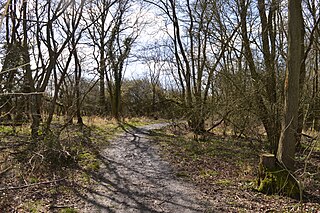
Rushbeds Wood is a 56-hectare (140-acre) nature reserve near Wotton Underwood in Buckinghamshire, managed by the Berkshire, Buckinghamshire and Oxfordshire Wildlife Trust (BBOWT). It is a surviving fragment of the ancient Bernwood Forest. The reserve is part of Rushbeds Wood and Railway Cutting, an 80.2-hectare (198-acre) biological Site of Special Scientific Interest. This includes a section of the Chiltern Main Line railway cutting, which runs along the north-east side of the BBOWT reserve.

Orton Pit is a 145.8-hectare (360-acre) biological Site of Special Scientific Interest on the southern outskirts of Peterborough in Cambridgeshire. It is also a Special Area of Conservation

Greens Norton Pocket Park is a 2-hectare (4.9-acre) Local Nature Reserve in Greens Norton in Northamptonshire. It is owned and managed by Green Norton Parish Council.

Padworth Common Local Nature Reserve is a 28-hectare (69-acre) Local Nature Reserve on the edge of the hamlet of Padworth Common, between Reading and Newbury in Berkshire. It is owned by West Berkshire Council and managed by Berkshire, Buckinghamshire and Oxfordshire Wildlife Trust.
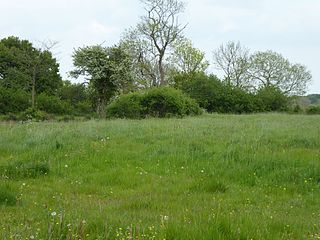
Dew's Ponds is a 6.7-hectare (17-acre) biological Site of Special Scientific Interest (SSSI) south of Halesworth in Suffolk. It is a Special Area of Conservation.

Ashford Warren and Hoads Wood is a 34.5-hectare (85-acre) nature reserve north of Ashford in Kent. It is owned by Ashford Borough Council and managed by Kent Wildlife Trust.

Peter's Pit is a 28.7-hectare (71-acre) biological Site of Special Scientific Interest north-east of Snodland in Kent. It is a Special Area of Conservation
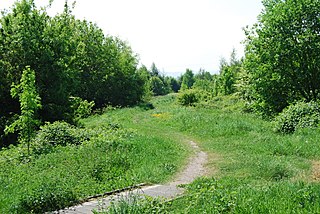
Bonc yr Hafod is a country park, on the former site of Hafod Colliery, near Johnstown and Pentre Bychan in Wrexham County Borough, Wales. The country park is centred on a former spoil tip hill, known locally as "Picnic Mountain", rising up 150 metres (490 ft). The country park is 90 acres (0.36 km2) in size of mainly woodlands and grasslands. The park is home to one of the largest community woodlands in North East Wales.

















